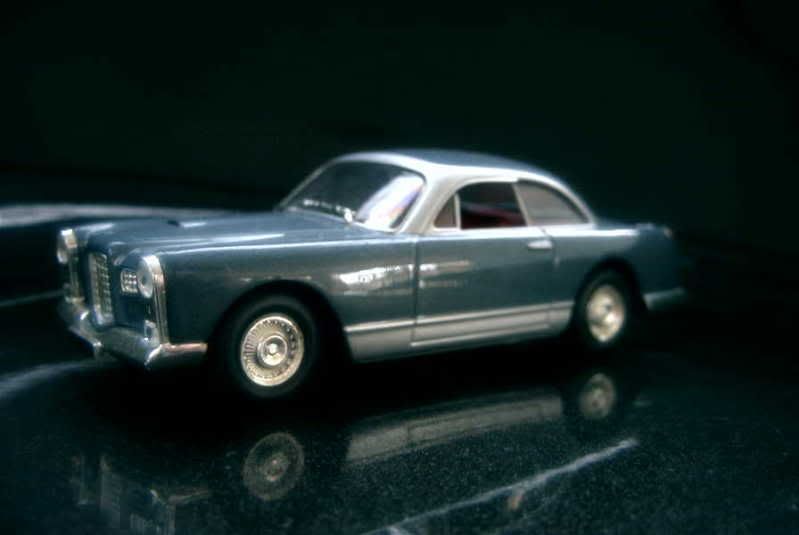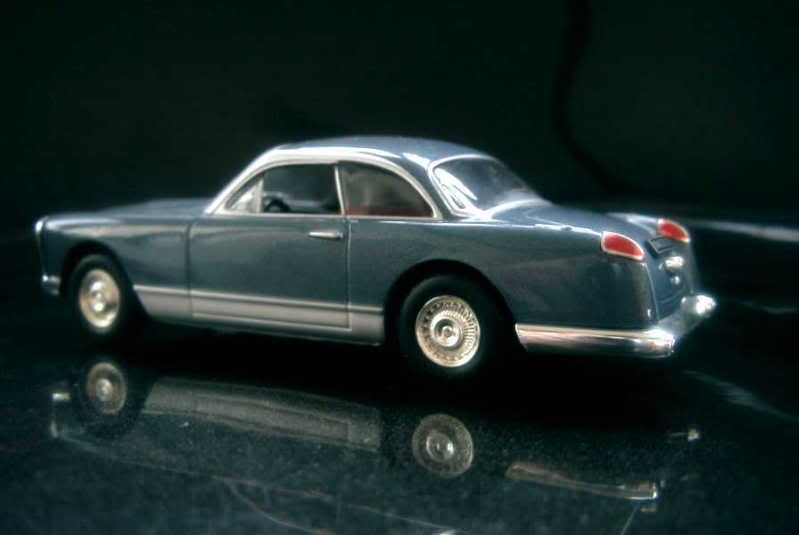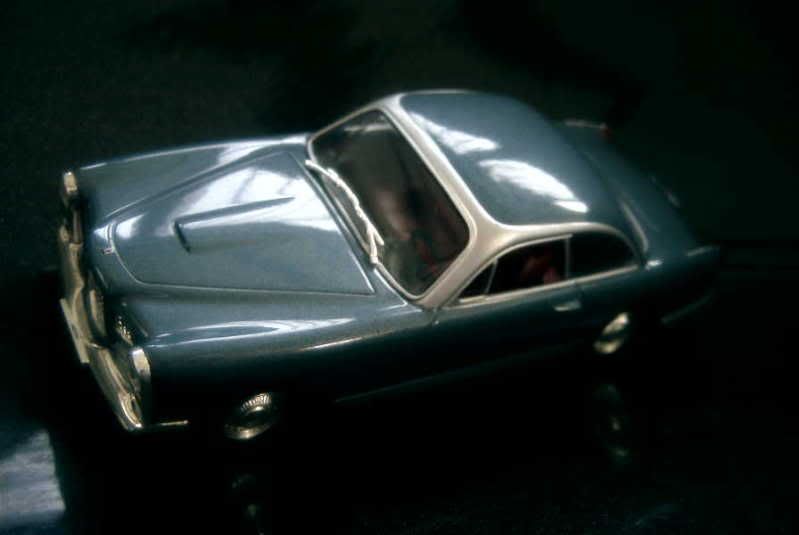A little history
By the early Fifties, it seemed that nothing could save the most prestigious names of the French automobile industry – and ultimately, nothing did. Delage, Talbot, Delahaye, Hotchkiss, Salmson were to be blown away by the new tastes of the affluent motorists both within France and abroad. However one man was eager to take up the challenge and create a new breed of French luxury cars: Jean Daninos.
Brother of a famous writer and owner of coachbuilder Facel Métallon, Daninos had made his company prosperous by supplying coupe or convertible bodies for low-production models from Simca, Ford, Delahaye and Panhard. The large amounts of money thus earned were spent designing an impressive sports car, the Facel Vega FV.
Unlike the prestigious models to which it succeeded at the pinnacle of French automotive refinement, the FV was anything but sophisticated mechanically. Inspiration came from across the ocean: built on a strong chassis fitted with drum brakes at each corner and a rigid rear axle, the new car was set in motion by the brute force of a De Soto 4.5-litre V8 provided by Chrysler. A three-speed automatic gearbox from the same origin was chosen – a rarity among the European production of the time, a detail which clearly indicates what market Daninos had in mind for his Facel Vega. Nevertheless a four-speed manual especially built for the FV by French company Pont-à-Mousson was optional for those with pins and needles in their left foot.
Facel Métallon had made itself known for its elegant designs; the FV didn’t disappoint anyone. It featured a low silhouette with long horizontal lines, neither interrupted nor overloaded by any of the chromed excesses American customers were becoming fond of. Up front, the headlights and parking lights were clustered on top of each other, flanking a squarish eggcrate grille. On the opposite end of the car, original lights rode on the ridge of the elongated rear fenders, while the twin exhausts exited through the bumper.
Both the specialized press and the public reacted favorably when the Facel Vega was first unveiled in July 1954. Though terribly expensive, the FV offered both extreme elegance and performance, and soon attracted as customers a crowd of celebrities looking for “something different”. Formula One greats Stirling Moss and Maurice Trintignant also drove Facels.
Though most Facel Vegas were hardtop coupes, a few convertibles were also produced. Furthermore a large hardtop sedan with rear suicide doors, the Excellence, was developed, becoming available for 1958. Interestingly the Excellence was considered for a time as the base for a new Packard, as the Studebaker-Packard Corporation didn’t have the financial capacities to design a new luxury car of their own. Despite its extremely low production volume (only 152 were ever made), the Excellence outlived the coupe and was built with only few modifications until its maker’s ultimate demise, in 1964.
Though the Facel Vega’s appearance didn’t change much throughout its production run, the ever-increasing displacement and output of the engines produced in Detroit pushed the Facel’s performances up. Born with 170 bhp, it was powered by a 390 bhp, 6.2-litre Chrysler V8 good for 225 kph when it finally became the HK500, its ultimate form between 1958 and 1962. That year, an even more extraordinary Facel II was presented.
About the model
Model: Facel Vega FV
Year: 1955
Maker: Ixo
Scale: 1/43
Distributed by: Altaya as no.16 of its Nos Chères Voitures d'Antan press series
Acquired: brand new, in December 2004, in France
Quite a decent model, with a very nice metallic blue-grey paint that befits it perfectly. It actually figures one of the first eleven Facel Vegas ever made, which had conventional windshields - from the twelfth model on, the FVs got a wraparound windshield. My rating is 15/20.




By the early Fifties, it seemed that nothing could save the most prestigious names of the French automobile industry – and ultimately, nothing did. Delage, Talbot, Delahaye, Hotchkiss, Salmson were to be blown away by the new tastes of the affluent motorists both within France and abroad. However one man was eager to take up the challenge and create a new breed of French luxury cars: Jean Daninos.
Brother of a famous writer and owner of coachbuilder Facel Métallon, Daninos had made his company prosperous by supplying coupe or convertible bodies for low-production models from Simca, Ford, Delahaye and Panhard. The large amounts of money thus earned were spent designing an impressive sports car, the Facel Vega FV.
Unlike the prestigious models to which it succeeded at the pinnacle of French automotive refinement, the FV was anything but sophisticated mechanically. Inspiration came from across the ocean: built on a strong chassis fitted with drum brakes at each corner and a rigid rear axle, the new car was set in motion by the brute force of a De Soto 4.5-litre V8 provided by Chrysler. A three-speed automatic gearbox from the same origin was chosen – a rarity among the European production of the time, a detail which clearly indicates what market Daninos had in mind for his Facel Vega. Nevertheless a four-speed manual especially built for the FV by French company Pont-à-Mousson was optional for those with pins and needles in their left foot.
Facel Métallon had made itself known for its elegant designs; the FV didn’t disappoint anyone. It featured a low silhouette with long horizontal lines, neither interrupted nor overloaded by any of the chromed excesses American customers were becoming fond of. Up front, the headlights and parking lights were clustered on top of each other, flanking a squarish eggcrate grille. On the opposite end of the car, original lights rode on the ridge of the elongated rear fenders, while the twin exhausts exited through the bumper.
Both the specialized press and the public reacted favorably when the Facel Vega was first unveiled in July 1954. Though terribly expensive, the FV offered both extreme elegance and performance, and soon attracted as customers a crowd of celebrities looking for “something different”. Formula One greats Stirling Moss and Maurice Trintignant also drove Facels.
Though most Facel Vegas were hardtop coupes, a few convertibles were also produced. Furthermore a large hardtop sedan with rear suicide doors, the Excellence, was developed, becoming available for 1958. Interestingly the Excellence was considered for a time as the base for a new Packard, as the Studebaker-Packard Corporation didn’t have the financial capacities to design a new luxury car of their own. Despite its extremely low production volume (only 152 were ever made), the Excellence outlived the coupe and was built with only few modifications until its maker’s ultimate demise, in 1964.
Though the Facel Vega’s appearance didn’t change much throughout its production run, the ever-increasing displacement and output of the engines produced in Detroit pushed the Facel’s performances up. Born with 170 bhp, it was powered by a 390 bhp, 6.2-litre Chrysler V8 good for 225 kph when it finally became the HK500, its ultimate form between 1958 and 1962. That year, an even more extraordinary Facel II was presented.
About the model
Model: Facel Vega FV
Year: 1955
Maker: Ixo
Scale: 1/43
Distributed by: Altaya as no.16 of its Nos Chères Voitures d'Antan press series
Acquired: brand new, in December 2004, in France
Quite a decent model, with a very nice metallic blue-grey paint that befits it perfectly. It actually figures one of the first eleven Facel Vegas ever made, which had conventional windshields - from the twelfth model on, the FVs got a wraparound windshield. My rating is 15/20.







No comments:
Post a Comment